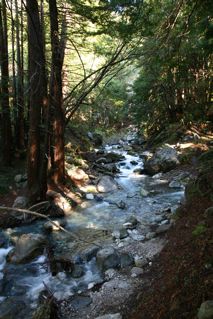A very special place.
I have been visiting Limekiln State Park for some time now. It is seventy miles or so from home, up Highway One, so no excuse is needed for the drive. Roughly midway between Cambria and Carmel on the central California coast, it offers magnificent ancient redwoods and waterfalls galore. Best of all, it’s generally deserted and though I have paid more than my fair share of California taxes, I do not feel too badly about the $6 entrance fee. It is a special place and sheer hell to photograph.
One reason is that you are simply overwhelmed by the beauty of the venue, meaning your first few trips result in lousy pictures. Then as you get to learn it you begin to appreciate the huge contrast range and begin to tackle it as best as you can. Unlike most landscape photography where the best lighting is early and late, Limekiln is best photographed between noon and 2 p.m., by which time the coastal fog has burned off and the sun is high enough in the sky to penetrate the dark forests of one hundred foot high redwoods. Then you get that magic light effect of sun dappled spots surrounded by this herd of ancient giants.
Up to now my best work there has been on 4â€x5†film, which means 1-8 second exposures on my favorite Kodak Portra VC160 film with the 90mm Angulon wide angle stopped down to f/22 or smaller in the perennial quest for depth of field. That means the massive Linhof tripod has to come along with the Crown Graphic and all those film holders. Well, by the time you get there, what with lugging all that gear, it feels like the cocktail hour. Anything to stop the shakes.
So today I tried something different. No excuse was needed to try the new toy, the Canon EOS 5D, but the gear was minimalist at best. The camera, the 24-105mm lens (OK, so it’s the only one I have. I’m making virtue out of necessity here), my little alloy monopod and that wonderful Leitz ball and socket head which I seem to have been born with. Add an inexpensive quick release plate on the camera and the monopod and you have the kit I used today.
Now I’m still sticking with 6mp JPGs. Not that RAW scares me but because I’m a dumb ass. In all my excitement when I was placing the order with B&H, all those eBay medium format sale proceeds burning a hole in my pocket, I forgot to order a couple of 1gB CF cards on which to store the large 13mB RAW files. The only CF card I have at home is a 256 mB used in the Olympus C-5050Z, the one with the one hour shutter lag, so I stuck that in the 5D while waiting for the big capacity cards from B&H to arrive. Boy, UPS must just love me. In fact the gate to the estate finally gave up the ghost today from all those deliveries…. JPG gets me 47 images, RAW 13. Now 24 is about right for me, so JPG it is for now.
I’m rapidly learning that to extract maximum dynamic range from digital your exposure has to be pretty much spot on. It feels like using slide film again. Maybe 1/2 stop tolerance either way. That means sharpening my skills as I’m used to the two stop latitude of color negative film. It also means that, in Limekiln’s dark interior, I finally used the built in LCD screen on the back of the 5D to optimize exposure. At least it was dark enough to see it. Several pictures were a stop out, so I erased them on the spot (that wretched 256 mB card!) and re-exposed. Two clicks on the Info button and you get a little picture on the camera’s LCD screen with the overexposed bits flashing at you. Now is that cool or what? The working dynamic was fascinating to compare with 4â€x5â€. Where the latter dictates f/16 or smaller apertures, meaning seconds of exposure. I cranked up the 5D to 400 ASA (oops! ISO. That dates me!) having learned that the big sensor in the camera shows no noise at this speed. 1 1/2 stops gained. Then I shot at f/4, the maximum aperture on the 24-105mm, as the lens is simply very, very sharp at all openings. 4-5 stops gained. Then I used the IS in the lens to cut vibrations for another three stops gained. That’s some 9 stops gained over 4â€x5â€, meaning I was shooting at 1/30th @ f/4, aided by the monopod. And the results are critically sharp. My back does not hurt and I don’t feel a day over 50 on arriving home.

Next time you visit here I shall be messing about with RAW. Is this a steep learning curve or what?